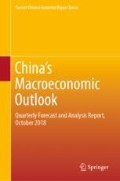Abstract
Since the second half of 2016, in order to prevent systemic financial risks and ensure China’s steady economic growth, China has implemented various macroeconomic policies, such as “tight credit”, “strong supervision” and “tight currency”, to suppress the rising debt rates of financial institutions, local governments and non-financial enterprises.
Access this chapter
Tax calculation will be finalised at checkout
Purchases are for personal use only
Author information
Authors and Affiliations
Corresponding author
Rights and permissions
Copyright information
© 2019 Springer Nature Singapore Pte Ltd.
About this chapter
Cite this chapter
Center for Macroeconomic Research (2019). Policy Simulation: Effects of Changes in the Household Debt Ratio on China’s GDP Growth. In: China‘s Macroeconomic Outlook. Current Chinese Economic Report Series. Springer, Singapore. https://doi.org/10.1007/978-981-13-6077-0_3
Download citation
DOI: https://doi.org/10.1007/978-981-13-6077-0_3
Published:
Publisher Name: Springer, Singapore
Print ISBN: 978-981-13-6076-3
Online ISBN: 978-981-13-6077-0
eBook Packages: Economics and FinanceEconomics and Finance (R0)

